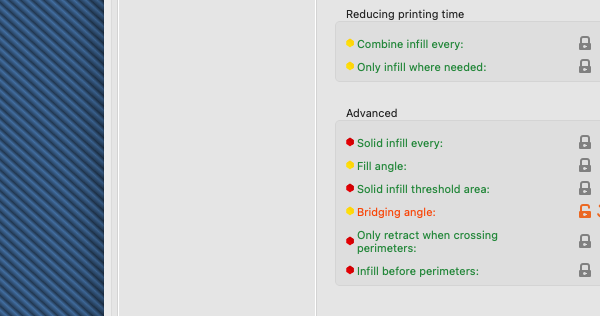Help deciphering support and bottom layer structure
I just printed a 80x120mm "table" - like object sort of like an open box turned upside down using TPU and a 0.6mm nozzle. In order to support the underside of the top, I used supports with:
- 5mm pattern spacing
- 3 Top interface layers
- 1mm interface pattern spacing
- 100% XY separation between object and its support
It came out mostly ok. The support was a bit difficult to remove, but came away in one piece. However, it looks like the layers aren't all running the proper directions.
I can count all 3 interface layers, 1mm spacing (7 filaments/10mm), well separated, attached to the basic support pattern (5mm spacing) and running perpendicular to it. When I detached the supports and interface, it left what looks like another layer, closer spaced than the 1mm interface spacing (17 filaments/10mm), running the same direction as the interface, attached to the bottom. The bottom is a tight pattern running diagonally.
When I peel back the individual layers in the slicer, the 17/10cm layer is labelled "Bridge infill". Exactly what is that and what is its purpose? Why is it running the same direction as the interface layers? Is there a way to control the direction of it or eliminate it? The first layer should span the interface layers just fine.
I printed this same object with a 0.4mm nozzle in PETG and the Bridge infill layer is running diagonally.
RE: Help deciphering support and bottom layer structure
From your 3mf, the bridge infill is simply the first layer of the surface that rests on top of your supports. You can change the angle under Print Settings>Infill>Advanced>Bridging Angle.
Formerly known on this forum as @fuchsr -- https://foxrun3d.com/
RE: Help deciphering support and bottom layer structure
From your 3mf, the bridge infill is simply the first layer of the surface that rests on top of your supports. You can change the angle under Print Settings>Infill>Advanced>Bridging Angle.
But why is it at the same angle as the underlying interface material? Shouldn't PS avoid that situation?
RE: Help deciphering support and bottom layer structure
Changing the bridging angle had no effect. I had to change the pattern angle under support material to make the supports run at 90 degrees to the default.
RE: Help deciphering support and bottom layer structure
Sure, changing the angle of the support is another option. But changing the bridging angle worked fine for me with the 3mf file you posted.
0 degrees angle (default):

45 degrees angle:"
Formerly known on this forum as @fuchsr -- https://foxrun3d.com/
RE: Help deciphering support and bottom layer structure
It may not have 'worked' due to the fact that 0 isnt zero degrees, its auto. So changing to 90 degrees and it might just be the same as the auto was already doing that angle. By forcing it to 45 degrees you can immediately see a visual difference.
If changing any of the 0 degree options and you dont see a difference then try both 90 and 180 first before assuming it isnt behaving as both those angles should produce patterns at right angles to each other.
RE: Help deciphering support and bottom layer structure
It may not have 'worked' due to the fact that 0 isnt zero degrees, its auto. So changing to 90 degrees and it might just be the same as the auto was already doing that angle. By forcing it to 45 degrees you can immediately see a visual difference.
If changing any of the 0 degree options and you dont see a difference then try both 90 and 180 first before assuming it isnt behaving as both those angles should produce patterns at right angles to each other.
Thanks, that was it.
But the question remains: Shouldn't Auto produce a result where the bridging is running in a direction other than that of the layer below it?
RE: Help deciphering support and bottom layer structure
Probably.
RE: Help deciphering support and bottom layer structure
Sure, changing the angle of the support is another option. But changing the bridging angle worked fine for me with the 3mf file you posted.
Thanks; tried again and it worked; must have been a dumb mistake/confusion.
